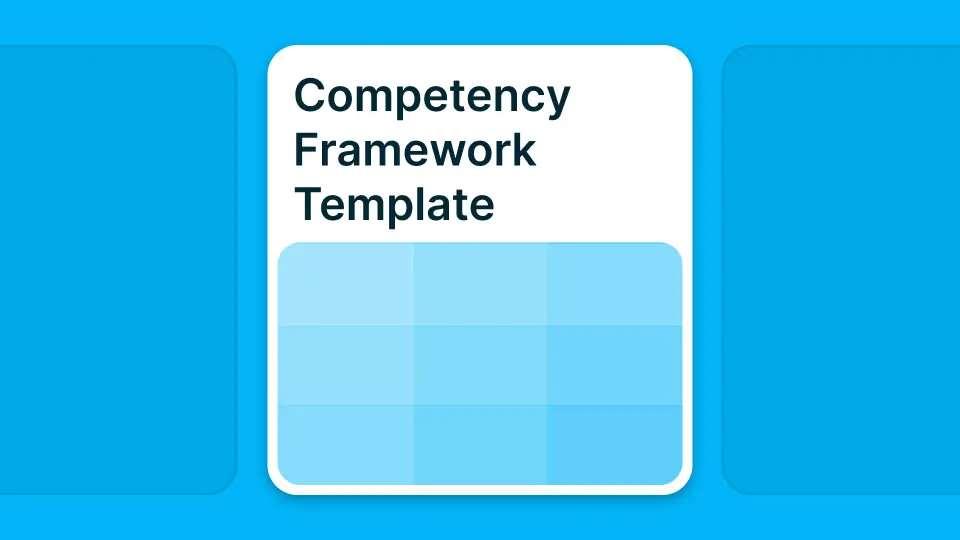Did you know that 89% of failed hires are due to a lack of role-specific competencies, not technical skills? This striking statistic from Leadership IQ reveals a critical gap in how organizations evaluate talent. Most companies focus heavily on technical abilities while overlooking the behavioral competencies that truly drive performance.
In this comprehensive guide, you'll discover instantly actionable competency framework templates tailored for roles like Engineering, Sales, Customer Success, and Operations. We break down exactly how to define behaviors by proficiency level—from Foundational to Expert—so you can build fair, effective frameworks that actually work for your team.
- Understand the crucial difference between competencies and skills
- Access ready-to-use templates with behavior descriptors per level
- See how leading companies connect frameworks to reviews, learning plans, and internal mobility
- Discover how AI tools automatically suggest and calibrate competencies at scale
Let's dive in and explore what makes a great competency framework template—and how you can put one into action today.
1. Understanding Competencies vs. Skills: Foundations for Your Framework
Before building any competency framework template, you need to distinguish between broad competencies and specific skills. This distinction forms the backbone of effective talent management. Yet according to Deloitte's Global Human Capital Trends (2023), only 41% of organizations have clearly defined the difference between skills and competencies.
Here's why this matters: A competency represents observable behaviors linked to success, while skills are task-specific abilities. For example, "communication" is a competency that encompasses multiple skills like writing clear emails, facilitating meetings, and presenting to executives. When you confuse the two, performance reviews become inconsistent and development plans miss the mark.
Consider this real-world example: A growing SaaS company struggled with performance reviews until they clarified that "problem solving" was a competency requiring multiple skills—like data analysis, creative thinking, and stakeholder management—at different proficiency levels. This clarity improved their promotion decisions by 35% within six months.
| Term | Definition | Example |
|---|---|---|
| Competency | Observable behaviors linked to success | Communication |
| Skill | Task-specific ability or knowledge | Writing clear emails |
| Proficiency | Level of mastery within a competency or skill | Expert-level negotiation |
To build your competency framework template effectively:
- Map out core competencies by role before listing granular skills
- Use behavioral indicators ("what good looks like") instead of vague adjectives
- Align skills under each competency for clarity in development plans
- Validate definitions with cross-functional subject matter experts (SMEs)
- Test your framework with a pilot group before company-wide rollout
Modern platforms like Sprad offer comprehensive taxonomies with over 32,000 pre-mapped skills, making this foundational work more efficient. The key is ensuring your framework reflects your organization's unique culture and performance drivers.
2. Structuring Proficiency Levels: From Foundational to Expert
Well-defined proficiency levels transform a static list of competencies into a dynamic tool for growth and assessment. Research from Gartner shows that multi-level frameworks improve promotion clarity by 27%, while companies with clear proficiency levels see 24% higher internal mobility rates according to the LinkedIn Workplace Learning Report.
The magic happens when you move beyond generic labels like "good" or "excellent" to behavior-based descriptors. Instead of saying someone has "advanced communication skills," your competency framework template should specify: "Consistently leads complex cross-functional meetings, adapts communication style to diverse audiences, and defuses tense situations diplomatically."
A global fintech firm exemplifies this approach. They implemented four proficiency bands—Foundational, Intermediate, Advanced, Expert—with specific behavioral indicators for each level. Their head of talent development noted: "Before, managers were all over the map with ratings. Now we have consistent language and clear expectations across 15 countries."
| Proficiency Level | Problem Solving Descriptor |
|---|---|
| Foundational | Identifies routine issues with guidance from senior team members |
| Intermediate | Resolves common challenges independently using established methods |
| Advanced | Anticipates complex obstacles and proposes innovative solutions |
| Expert | Coaches others in problem analysis and shapes organizational approaches |
To structure effective proficiency levels in your competency framework template:
- Set 3–5 distinct proficiency levels per competency (avoid too many gradations)
- Write behavior-based descriptors for each level with observable actions
- Calibrate levels using manager calibration sessions or peer review panels
- Revisit descriptors annually based on employee feedback and role evolution
- Link each level to sample outcomes or deliverables where possible
Tools like Atlas AI can auto-suggest proficiency descriptors based on industry best practices, but the final calibration should always involve your subject matter experts who understand your unique business context.
3. Role-Based Competency Mapping: Engineering, Sales, CS & Ops Examples
Generic competency frameworks fail because they treat all roles the same. Effective frameworks are tailored—not one-size-fits-all. Each role needs its own mapped set of competencies with relevant descriptors that reflect daily realities. McKinsey research demonstrates that tailored frameworks boost job performance metrics by up to 19%, yet only 36% of companies customize frameworks per function according to Mercer Talent Trends.
The difference is striking when you see it in action. A mid-sized e-commerce company created separate competency matrices for different functions: Engineers focused on technical depth and system thinking, Sales emphasized negotiation and relationship building, Customer Success prioritized empathy and retention strategies, while Operations centered on process discipline and efficiency optimization. This tailored approach reduced new hire ramp time by two months and improved internal promotion success rates by 40%.
Your competency framework template should capture both universal competencies (like collaboration) and role-specific ones (like technical architecture for engineers or pipeline management for sales). The key is adjusting behavioral descriptors so they resonate with each function's daily work.
| Role | Core Competency | Advanced Level Descriptor |
|---|---|---|
| Engineering | Problem Solving | Designs scalable solutions under technical and business constraints |
| Sales | Customer Focus | Tailors complex pitches based on nuanced client business needs |
| Customer Success | Communication | Defuses tense escalations while maintaining long-term relationships |
| Operations | Process Discipline | Streamlines cross-functional workflows proactively to prevent bottlenecks |
To create effective role-based mapping:
- Identify mission-critical competencies per function through SME interviews
- Adjust behavioral descriptors to reflect realistic work scenarios for each role
- Include both universal and unique competencies per job family
- Share draft frameworks with employees for feedback before rollout
- Version control your templates as roles evolve with business needs
Many organizations find success starting with proven templates and then customizing for their context. Sprad's extensive skills taxonomy can serve as an excellent foundation, offering thousands of pre-validated competencies across different functions and industries.
4. Core Competency Templates with Multi-Level Behavior Descriptors
Universal competencies like leadership, collaboration, and communication require precise behavioral definitions at every level so teams share a common language. Research from Harvard Business Review shows that teams using detailed behavior descriptors report a 21% drop in rating disputes during performance reviews.
The challenge is moving beyond abstract traits to observable actions. Instead of "demonstrates good leadership," your competency framework template should specify exactly what leadership looks like at each proficiency level. A biotech company discovered this when they replaced vague collaboration descriptions with explicit behaviors like "actively seeks input from diverse voices" and "synthesizes conflicting viewpoints into actionable solutions." Their project delivery timelines improved by three weeks on average.
Here's how core competencies translate across proficiency levels:
| Leadership Competency Framework Template | |
|---|---|
| Level | Behavior Descriptor |
| Foundational | Seeks guidance when making decisions affecting team outcomes |
| Intermediate | Influences peers through clear communication and consistent follow-through |
| Advanced | Drives change initiatives across teams while managing resistance effectively |
| Expert | Shapes organizational vision and mentors emerging leaders at scale |
| Communication Competency Framework Template | |
|---|---|
| Level | Behavior Descriptor |
| Foundational | Shares information clearly in familiar contexts with supportive audiences |
| Intermediate | Adapts message and medium for different stakeholders consistently |
| Advanced | Facilitates difficult conversations and builds consensus among diverse groups |
| Expert | Influences strategic decisions through compelling storytelling and data presentation |
To develop robust core competency templates:
- Define observable actions for each competency at every proficiency level
- Avoid abstract traits and focus on what others can actually see or hear
- Use real scenarios from your business context when writing descriptions
- Pilot new descriptors with a small group before scaling company-wide
- Update regularly based on evolving organizational culture and strategy
The most successful organizations combine proven frameworks with their unique culture. Sprad's competency library provides research-backed templates, while tools like Atlas AI can suggest behavior descriptors based on your industry and role requirements, saving significant development time.
5. Calibration and Validation: Ensuring Fairness and Accuracy
Even the best competency framework template fails without proper calibration and validation processes. Calibration ensures ratings are consistent across managers and teams, while validation confirms that your framework truly reflects what drives success in each role. CEB research reveals that regular calibration cuts performance review bias in half, yet only 22% of firms recalibrate their frameworks annually.
The stakes are high when calibration is missing. One global logistics provider discovered this when exit interviews revealed that high performers were leaving because they felt performance reviews were "random" and "unfair." The company implemented quarterly cross-functional calibration panels where managers reviewed anonymized performance examples against their competency framework template. Within a year, review inflation complaints dropped by over one third.
Validation goes deeper than calibration—it asks whether your competency framework template actually predicts success. This involves analyzing performance data, gathering employee feedback, and adjusting descriptors based on real outcomes. Smart organizations treat their frameworks as living documents, not static policies.
| Governance Step | Description | Key Benefit |
|---|---|---|
| Calibration Session | Managers align ratings using real performance examples | Consistency across teams and regions |
| SME Validation | Subject matter experts confirm relevance and accuracy | Framework reflects true job demands |
| Version Control | Track all updates with clear rationale and timeline | Prevents confusion and inconsistency |
Essential calibration and validation practices:
- Schedule regular manager calibration sessions around performance review cycles
- Bring in SMEs from multiple business units for comprehensive validation workshops
- Collect anonymized employee feedback after each review period
- Document all changes with version history and transparent rationale
- Establish a formal governance committee responsible for framework updates
Modern AI tools like Atlas AI are emerging as powerful calibration aids, using machine learning to suggest consistent leveling based on performance data patterns. However, human judgment from your SMEs remains crucial for context and cultural fit. The most effective approach combines data-driven insights with expert validation to create frameworks that are both fair and predictive of success.
6. Integrating Frameworks into Performance Reviews and Talent Processes
The real power of a competency framework template comes alive when embedded into everyday HR tools—from annual reviews to learning plans and internal mobility programs. LinkedIn data shows that companies integrating frameworks into performance management see up to 39% improvement in succession planning accuracy. Yet only about half of organizations fully link their frameworks with talent systems according to Brandon Hall Group research.
The integration challenge is real, but the payoff is substantial. An international retailer revamped its entire performance process so every goal and evaluation criterion mapped directly back to key competencies in their framework template. Managers used the same behavioral language in feedback forms, employees could self-assess using familiar descriptors, and development plans automatically suggested resources based on competency gaps. The result: promotions-from-within rates nearly doubled over two years.
Successful integration requires more than just copying competency names into review forms. You need consistent language, clear connections between processes, and user-friendly tools that make the framework helpful rather than bureaucratic. The best implementations feel seamless to employees and managers alike.
| Talent Process | Framework Integration Example | User Impact |
|---|---|---|
| Performance Review | Reviewer rates "Advanced" communication using specific behavioral descriptors | Clear expectations and fair evaluations |
| Learning Plan | Training modules target "Intermediate" problem solving competency gaps | Personalized development that connects to career growth |
| Internal Mobility | Job postings specify "Expert" customer focus requirement with behavioral examples | Transparent promotion criteria and realistic self-assessment |
Key integration strategies for your competency framework template:
- Connect each review criterion directly to specific framework behaviors and levels
- Use identical language in feedback forms as found in your competency templates
- Build automated learning recommendations around areas where employees are developing
- Enable accurate self-assessment via digital tools referencing the same descriptors
- Support internal mobility decisions with transparent competency requirements
The technical integration varies by organization—some use APIs to connect frameworks directly to HRIS and LMS platforms, while others start with manual uploads and evolve toward automation. Sprad's platform exemplifies seamless integration, connecting competency frameworks with skills assessments, learning recommendations, and career pathing in a unified experience.
7. Ready-to-Use Templates and Advanced Tools for Scale
Building competency framework templates from scratch consumes months of valuable time. Smart HR teams leverage expertly-designed templates and modern technology to accelerate implementation while ensuring quality. Market surveys show users save an average of six weeks' work by starting with proven templates rather than building from zero.
The landscape of available resources has transformed dramatically. Sprad's skills taxonomy now includes over 32,000 pre-mapped competencies and skills, covering virtually every role and industry. Meanwhile, AI-powered tools like Atlas AI can auto-generate behavioral descriptors and suggest proficiency levels based on industry benchmarks and your organization's specific context.
A series-A startup demonstrates this approach perfectly. Their HR team downloaded foundational templates, customized them for their culture and roles, then used Atlas AI's auto-suggestion features to rapidly iterate and refine their competency framework template. What would have taken months of internal development was completed in three weeks, allowing them to focus on training managers and embedding the framework into their growing team.
| Resource Type | What It Provides | Best Use Case |
|---|---|---|
| Free Downloadable Templates | Ready-made competency matrices per role and level | Quick start for standard roles |
| Sprad Skills Taxonomy | Comprehensive library with 32,000+ validated competencies | Ensuring completeness and industry alignment |
| Atlas AI Auto-Suggest | Machine-generated behavioral descriptors and level calibration | Scaling across many roles efficiently |
To maximize your template and tool strategy:
- Start with proven templates that match your industry and role requirements
- Customize behavioral descriptors based on your company values and performance drivers
- Leverage AI tools like Atlas AI for initial drafts, then refine with SME input
- Join HR communities and forums where practitioners share real-world examples
- Plan for ongoing updates as your organization and roles evolve
The combination of quality templates and smart technology creates a powerful foundation for your competency framework. Whether you're building your first framework or upgrading an existing one, these resources can dramatically reduce time-to-value while improving the accuracy and adoption of your final result. The key is choosing tools that integrate well with your existing HR technology stack and support your long-term talent management strategy.
Conclusion: Building Practical Competency Frameworks That Drive Results
Effective competency framework templates transform how organizations develop, evaluate, and promote talent. The research is clear: companies with well-designed, behavior-based frameworks see measurable improvements in performance review fairness, internal mobility rates, and succession planning accuracy.
Three critical insights emerge from our exploration:
Foundation matters most: Clear separation between competencies and skills, combined with behavior-based proficiency levels, creates the solid ground that everything else builds upon. Without this clarity, even the best intentions lead to inconsistent applications and frustrated employees.
Customization drives adoption: Role-based templates with relevant behavioral descriptors resonate with employees and managers because they reflect real work scenarios. Generic frameworks feel abstract and disconnected from daily performance.
Integration amplifies impact: Competency frameworks reach their full potential when seamlessly connected to performance reviews, learning plans, and career development processes. Isolated frameworks, no matter how well-designed, remain unused.
Your next steps should focus on practical implementation. Start by auditing your existing frameworks against the behavioral descriptor examples we've shared. Engage subject matter experts from every business unit for initial mapping and calibration sessions that ensure accuracy and buy-in. Consider piloting your updated approach in one department before scaling organization-wide, allowing you to refine based on real feedback.
As work continues evolving rapidly—with generative AI reshaping roles and remote work changing collaboration patterns—the most successful HR teams will maintain living, adaptive competency frameworks. The combination of expert human insight and smart technology tools creates frameworks that stay relevant while driving consistent talent decisions across your organization.
Frequently Asked Questions (FAQ)
What is a competency framework template?
A competency framework template is a structured document that outlines key behavioral competencies and their corresponding proficiency levels for specific roles or job families. It defines what success looks like at each level—from foundational through expert—using observable behaviors rather than vague descriptions. These templates serve as the foundation for hiring decisions, performance evaluations, development planning, and internal mobility by creating consistent language and expectations across your organization.
How do I create role-based competency matrices for different functions?
Start by conducting interviews with subject matter experts from each function to identify mission-critical competencies specific to that role. Map out observable behaviors at each proficiency level using real work scenarios that resonate with employees in that function. For example, "problem solving" for engineers might emphasize technical architecture and system constraints, while for sales roles it might focus on overcoming objections and adapting proposals. Always validate your drafts with both managers and employees before final rollout to ensure the descriptions reflect actual job demands.
Why are detailed proficiency levels crucial in competency framework templates?
Detailed proficiency levels provide clear career progression pathways and enable fair, consistent performance evaluations. Without specific behavioral descriptors at each level, managers interpret competencies differently, leading to rating inconsistencies and employee frustration. Well-defined levels help employees understand exactly what they need to demonstrate to advance, while giving managers concrete criteria for assessment and development conversations. Research shows this clarity improves internal mobility rates by up to 24%.
Can I find free competency framework templates for download?
Yes, numerous high-quality templates are available for download from HR platforms, professional associations, and talent management providers. Many organizations offer role-specific matrices covering functions like engineering, sales, customer success, and operations. Additionally, comprehensive libraries like Sprad's skills taxonomy provide access to thousands of validated competencies across industries. The key is starting with proven templates and then customizing the behavioral descriptors to match your organization's culture and performance expectations.
How do I keep my competency framework current and calibrated over time?
Establish regular governance processes including quarterly manager calibration sessions where teams review real performance examples against your framework criteria. Schedule annual validation workshops with subject matter experts to ensure competencies still reflect job requirements as roles evolve. Collect ongoing feedback from employees post-review to identify areas where descriptors need updating. Maintain clear version control documenting all changes with rationale. Modern AI tools like Atlas AI can also help by suggesting updates based on industry benchmarks and performance data patterns, though human validation remains essential for cultural fit.











